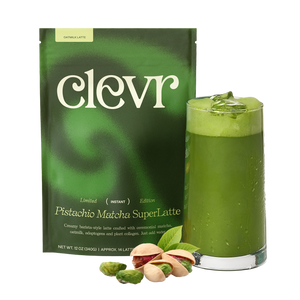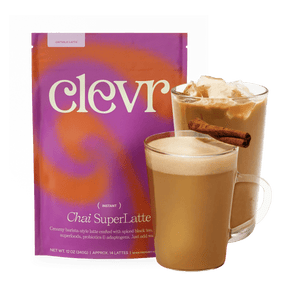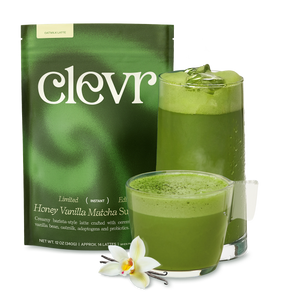
The Scoop on Monk Fruit
This centuries-old fruit in our SuperLattes has all the sweetness, none of the sugar.
This centuries-old fruit in our SuperLattes has all the sweetness, none of the sugar.
We’re sticklers for nourishing our bodies. That’s why our SuperLattes are infused with good-for-you ingredients like probiotics and brain-boosting mushrooms. Even the way we sweeten our Lattes comes with health perks.
Ever since we started Clevr Blends in 2019, we knew that sugar — and its nasty side effects like energy crashes and headaches — wasn’t going to cut it for our recipes. We were committed to finding a natural option that offered the same sweet notes without the blood sugar spikes. That’s when we looked to monk fruit, which gets its sweetness from antioxidants rather than fructose or glucose.
Sorcery? Hardly. Here’s your quick primer on our go-to natural sweetener.
Backstory
A green, melon-like plant native to southern China, monk fruit dates back to the 13th century (Weil, 2018) and is said to have first been used by Buddhist monks — hence the English moniker. It’s been a fixture of traditional Chinese medicine for just as long, revered as a tonic, usually in teas and drinks, for colds, sore throats, and lung congestion (Scientific Reports, 2021).
But beyond helping to ease those coughs, monk fruit has also been long used as a natural sweetener, made by removing the seeds and peel, then squeezing and dehydrating the juice into a fine powder.
Benefits
Unlike honey or dates, which rely on fructose or sucrose, monk fruit gets its sweetness from the antioxidant mogroside, not sugar molecules (Journal of Food Science and Technology, 2018). And though this plant is zero-calorie and clocks in low on the glycemic index — meaning it won’t spike your blood sugar levels — it’s still 100-250 times sweeter than sucrose thanks to those mogrosides, which even have anti-inflammatory perks (Nutrients, 2019; Journal of Agricultural and Food Chemistry, 2011).
Beyond the Mug
Monk fruit is a natural — get it? — fit for baking projects, but keep in mind that a little goes a long way. Not all versions are made for a 1-to-1 swap with sugar, so be sure to read your labels carefully (WhatSugar blog, 2021).
Ask the Formulator...
Clevr CEO and Formulator Hannah Mendoza answers some of your burning questions.
Why not use honey or another natural sweetener?
“While we love responsibly sourced, local honey, it’s not vegan and doesn’t mesh with our plant-based ethos. Not to mention, it’s difficult to find a honey extract or honey powder supplier that’s aligned with our strict sourcing requirements. (Location and sustainable practices matter!)
With Stevia, it honestly came down to taste. We couldn’t achieve a blend with Stevia that hit all the right flavor notes and didn’t have that metallic aftertaste. Monk fruit became a key ingredient in unlocking the right amount of sweetness for our SuperLattes.”
The monk fruit blend is mixed with erythritol. Aren’t there health risks?
“Certain sugar alcohols can upset your stomach or cause other unsavory symptoms, but thanks to its unique chemical composition, erythritol doesn’t interact with our GI tract in the same way (International Journal of Dentistry, 2016). So long, stomach issues!
Quality can also make a difference. That’s why our monk fruit sweetener blend has a balanced flavor with responsibly sourced ingredients — for our Coffee SuperLatte, 6 grams of non-GMO certified erythritol in a 3 tablespoon serving and 7 grams in our Chai SuperLatte. We worked hard to perfect the ratio of monk fruit and erythritol to mimic the classic sweetness we know and love with none of the sugar.
We understand it may not be for everyone and that's OK! It's a crowd favorite and an ingredient we're proud to stand behind given the lengths we went to find something we love that also felt good in our bodies.”
































